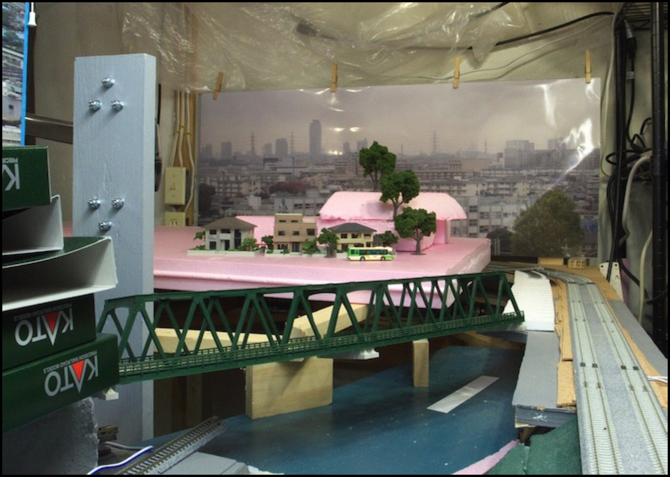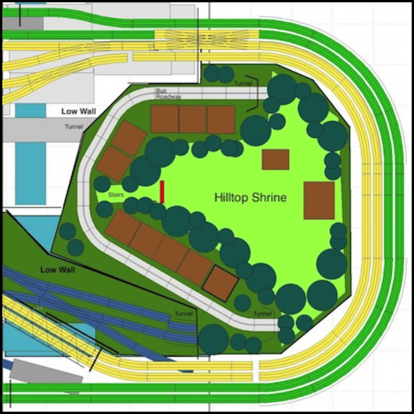Mocking Up the Hilltop

It’s very pink, but with a bit of imagination you can see the forested hill rising behind the houses, which will have a small Shinto shrine tucked in amongst the trees, with a stairway down to street level, a very typically Japanese scene. This mock-up was part of my final refinement of the design for the Hilltop Scene. I’m not quite done, but I’m beginning to accept that I have a sound idea for what I want to do.
The other thing to notice in this photo is the bus. That’s not simply because it was handy, so I grabbed it to mark the location of the street, although that is part of the reason it’s there. But the other part is that I realized that I could fit in a loop of roadway for the Tomytec Moving Bus System, and add some motion to the hilltop scene. I may even put a bus stop at the base of the stairs to the shrine.

Current Plan
As you can see above, the roadway will wrap around the front (left in this diagram) part of the hilltop, between the urban station on one side, and the tracks leading to the Riverside Station scene on the other, but run around the back inside the hill via a tunnel. I can fit about ten houses around the front if I want (those brown squares are 81mm on a side, the typical footprint of a Kato house). And I’ll have plenty of room up top for the open space and several buildings typical of a Shinto shrine.
Shinto is one of the two religions widespread in Japan, the other being Buddhism. Most Japanese practice both, and at times in the past the two have been merged, although today they are largely practiced in distinct facilities (Shinto Shrines and Buddhist Temples). Christianity, despite being introduced several hundred years ago, is at best a distant third in terms of popularity with only 1% of the population identified as Christians. Shinto shrines are a very important aspect of Japanese culture, and typically sited in small pockets of nature even within cities. If you’re curious, there is very detailed overview of the history and modern-day role of Shinto here.
This weekend, I finally ordered the shrine kit (Tomytec The Building Collection 010-2 Shinto Shrine 2, Vermillion Lacquering Shinto Shrine). This is an updated version of their Shinto Shrine set, with red-colored buildings (red is typical of Inari, the fox deity of prosperity, the most common type of shrine in Japan).
Additional work on the backdrop is ongoing. At the moment the photo has not yet been glued to it (it’s held on by clothespins in the mock-up) as I’m still working on the support structure for the backdrop, which entails a lot of handling of the backdrop itself. Once I get that done (soon), I’ll be gluing the photo to it and bolting the backdrop to the frame. I picked up a fresh bottle of the glue I use, Paper Mod-Podge, the other day, so I’m all set to do it.
After that, I need to finalize the wooden structure that forms the base of the hilltop, which will rest on the layout support frame and hold the pink foam above it (I’ll likely glue the foam to the wood using a glue compatible with both, liquid nails perhaps). Then I need to cut and carve chunks of the pink insulation foam to the needed shapes, glue them together (while leaving provision to remove the top of the hill for access to the bus roadway), plaster, paint and scenic the foam, and put down buildings.
None of this is particularly hard, and I’ve done all of it before on other parts of the layout. I’m still likely to take a long time doing it, simply because I like to stop and think before taking any actions that are hard to undo. It’s not really the best way of getting things done; often it’s better to dive in and just do them. But it’s the way I usually operate. As a result, it’s likely to be months yet before I’m done, but getting a mock-up I like was a major step in the overall process.



